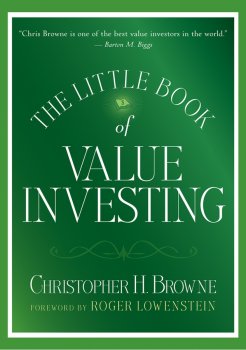The Tweedy, Browne Value Investing Strategy
Originally serving as stock broker to the father of value investing, Benjamin Graham, Tweedy, Browne & Company converted to a money management company and eventually launched several highly successful mutual funds that operated with the same value investing style for which they had become renowned. After beating the market by several percentage points for nearly forty years, the firm’s place in the halls of investing greats has been securely established.
In his book, The Little Book of Value Investing, the late Christopher Browne laid out how he and the other Managing Directors of Tweedy, Browne & Company put the value investing principles they learned from Benjamin Graham to work each day when they arrived at the office.
The Value Investing Secret: Keep 3 Years Worth of Spending Parked In Bonds
Christopher Browne recommended that those who want to follow a disciplined value investing strategy keep three years’ worth of spending money parked in safe, investment grade bonds. That way, when the market crashes, you can avoid selling shares to support your lifestyle needs, liquidating the bonds, instead. Although simple, this strategy can be incredibly effective by helping avoid the need to sell assets in the event they become even more undervalued after you purchased them.
Then, and only then, should the value investor move on to selecting individual stocks.
The Most Important Questions Every Value Investor Should Ask About a Stock
 Once you’re ready to put together a portfolio of value investing stocks, it’s time to begin the research process. Browne said that the folks at Tweedy, Browne & Company focused on several questions when examining potential value stocks. These were:
Once you’re ready to put together a portfolio of value investing stocks, it’s time to begin the research process. Browne said that the folks at Tweedy, Browne & Company focused on several questions when examining potential value stocks. These were:
- What is the outlook for pricing the company’s products? Can the company raise prices? How much of that price increase will fall to the bottom line?
- Can the company sell more? What is the outlook for units?
- Can the company increase profits on existing sales? What is the outlook for the gross profit margin as a percentage of sales? How much is the gross profit margin expected to increase or decrease as a result in changes in price, mix of business, or the specific costs that make up the cost of goods sold?
- Can the company control expenses?
- If the company does raise sales, how much of the increase will fall to the bottom line?
- Can the company be as profitable as it used to be, or at least as profitable as its competitors?
- Does the company have one-time expenses that will not have to be paid in the future?
- Does the company have unprofitable operations it can shed?
- Is the company comfortable with Wall Street’s earnings estimates?
- How much can the company grow over the next five years? How will the growth be achieved?
- What will the company do with the excess cash generated by the business? Every dollar of profit not given to the shareholders in the form of dividends will be retained by the company. What does management intend to do with it?
- What does the company expect its competitors to do?
- How does the company compare financially with other companies in the same business?
- What would the company be worth if it were sold?
- Does the company plan to buy back stock?
These questions will help you determine whether a stock is undervalued relative to the market’s expectations for future earnings. This approach has worked wonders for value investors who entrusted their money to Tweedy, Browne. After fees, Tweedy, Browne & Company has beat the S&P 500 by nearly 2% points per year for 40 years. That may not seem like a lot, but for someone who saved $10,000 per year, it’s the difference is startling: Someone who invested in the S&P 500 would have retired with $7,670,914 whereas an investor with Tweedy, Browne & Company would have sailed away into their golden years with a personal nest egg of more than $17,790,903. For most people, an extra $10,119,989 is worth the extra work required to understand stock valuation!
The Importance of Low Turnover for a Successful Value Investing Strategy
Tweedy, Browne has done considerable research on the influence of portfolio turnover on after-tax compound annual rates of return for investors. For those who hold their shares through regular brokerage accounts or other non-tax advantaged accounts, the cumulative results over several decades is almost unbelievable. For instance, assuming 27% taxes and a 15% rate of return, a $100,000 initial investment with 3% turnover will have grown to $1,478,080. The same portfolio with turnover over 100% would be worth only $799,000, or just more than half of the low turnover value investing portfolio.
Seek Widespread Diversification for a Sound Value Investing Strategy
Warren Buffett can concentrate his holdings because Berkshire Hathaway itself is so widely diversified. Tweedy, Browne & Company, however, believes that investors should practice widespread diversification just like Benjamin Graham taught when he pioneered the concept of value investing more than eighty years ago. This is evident in the worldwide value investing mutual funds they manage, where it’s rare to see a company account for more than 3% to 5% of assets.
[mainbodyad]


